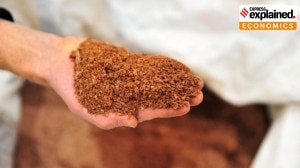Theatre Of Body & Mind
A male dancer performing on stage in a langoti? What's more, he does it with grace and energy, delicate and dynamic body-language. These ...

A male dancer performing on stage in a langoti? What’s more, he does it with grace and energy, delicate and dynamic body-language. These are the `polarities’ that form the subject-matter of Veena Pani Chawla’s Brhannala that has been performing to admiring audiences around the country and recently caught the attention of theatre-buffs at the National Theatre Festival in Delhi.
The actor in the solo performance, Vinay Kumar is a theatre-graduate and Kodiyattam dancer from Kerala, Veena is a Punjabi who grew up in Bombay, the rest of the group came from all over the country, as also France. And guess where they all are based? In Pondicherry! This multi-cultural psyche forms the background of Adishakti, the group formed by Chawla, whose main aim has been to create a new aesthetic language for theatre. A language that combines the physical and the philosophical.
"We make the body the space of the drama" says Vinay Kumar, whose Rodin-like sculpturesque body culls out the male-female theme of the drama with energy and ease. As he flutters his eyes and wiggles his hips, he could be Brhannala or the female Ardhanarishwara. But he can also swing the bow and fight with strength like Arjuna or Siva. He can be the soft-toned tiger, or the fierce-voiced dog, the athletic cricketer, or the cerebral scientist.
Veena evokes all these images in her drama because as she says, "Symbolism and Allegory are Theatre’s strengths. Where Reality is concerned, the Cinema can do everything better". They delved through the Mahabharata, the Draupadi cult texts of Tamilnadu, the Greek myths, Einstein’s theories of Time and Space, Aurobindo’s theory of Dharma, the `cerebral’ rules of cricket, to put together her theme of polarity in this drama. Brhannala, finally, is only a symbol for a story that tries to find connections between so-called opposites – the male and female, the man and animal, the pragmatic and creative.
Vinay Kumar performs with a duality of tone. His language is English but the accent, expressions, and style are all Malayali. "Why should I talk like the Brits?", asks the actor from Trichur, "Why should I lose my essence as a Malayali?". Veena says she chose the Kerala-texture in her drama because of her long association with Kodiyattum which she chose as the style for this drama. Many musical instruments associated with this dance-form like the edaka and mizhavu are used. There are an amazing range of other instruments too, like the Korean gong, Red-Indian drum, ghattam, snare, nagada, and a unique range of flutes created by Aurelio, a Pondicherry-based French musician, who’s researching on the theory of sound.
Veena said that she took more than a year to research on and write the text. But putting it together was a delightful experience, based totally on improvisations with her group. The musicians spontaneously `responded’ to the script, and the ensuing array of sounds lifts the text to a marvelous new dimension. As for Kumar, Veena asked him to be as colloquial as possible in his interpretation of Arjuna, and that accounted for the debunking of the Mahabharata-hero image. The same way that she had debunked the heroic Bhima in her much acclaimed production, Impressions of Bhima, which Vinay Kumar had again essayed with masterful ease, to raving audiences in India and abroad.
But Veena doesn’t claim to have any answers to the question of the male-female polarity. "It took a female mind like me to conceive this drama but I chose a male artiste to translate it for me" – she laughs. As far as Adishakti is concerned, it’s the duality of the group that accounts for their individuality.





- 01
- 02
- 03
- 04
- 05


























